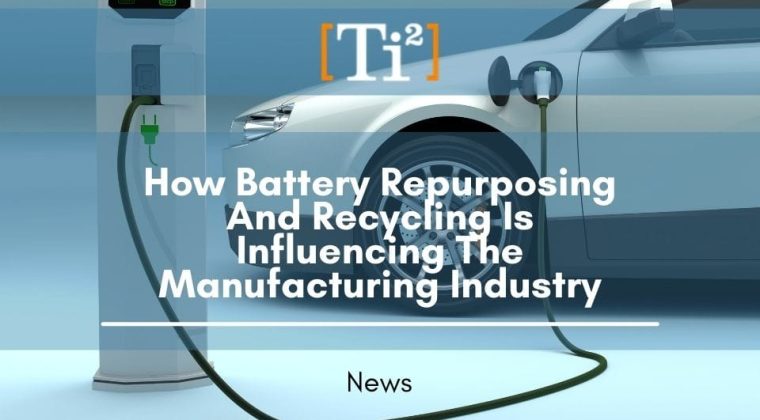
How Battery Repurposing And Recycling Is Influencing The Manufacturing Industry
The manufacturing industry is revolving into a very sustainable one. Today, maintaining is considerably of higher importance than innovation in business. Innovation may happen once a year but maintaining, repurposing, and recycling is a continuous process.
In the goal of decarbonisation, to minimise the emmitence of CO2 into the atmosphere, more research and development is being conducted in the renewable energy industry. The latter has raised a new topic to investigate and improve – battery storage. Repurposing and recycling of batteries has a huge potential to contribute to sustainable development of the industry.
Advances in battery technologies will allow a more affordable and efficient costing, while providing reliable and clean energy. Battery prices have already decreased by 88% during the last decade, but are predicted to decline even further.
With urban and rural energy requirements, battery storage is an excellent option for remote energy generation and storage. Inaccessible areas may require a new system of supply chain from sourcing, manufacturing, grid development, output management, usage, and operational, but repurposing and recycling batteries are expected to highly improve the environmental footprint of batteries.
Transport and power sector plays a major role in global emission. According to the Electric Vehicle Council, 8,688 electric vehicles have been sold in Australia in 2022 alone, representing 1.57% of the total light vehicle market. In 2021, Australia recorded 20,665 EV sales, which holds a significant increase from the 6,900 sold in 2020.
Sales of electric cars have been increasing and are forecasted to increase at a rapid rate in the coming year. With electric mobility, the potential of batteries shifting from fossil fuel is a strong outlook.
However, there are some concerns with EV batteries, when it’s sourced and manufactured from lithium ion. There are some environmental impacts of extracting lithium, the supply amount of reserves, the emissions from the battery manufacturing process itself, as well as the toxic waste from used batteries disposal.
As batteries turn to trash, chemicals may soak into the soil and contaminate ground and surface water. Our ecosystem will be compromised, harming animals, plants and even humans when exposed to battery chemicals. Tap water contamination may not only cause internal disease when ingested, but also skin diseases when used externally.
This is why it’s important for manufacturers to focus on environmental impact assessment before manufacturing any battery-using products.
On the positive side, batteries allow us to store energy and minimise the negative impact on the environment, and the recycling and repurposing of batteries will allow an improved circular economy. This will reduce material use, reduce resources intensivity, and highly reduce battery waste to manufacture new products and materials.
By 2050, batteries are expected to account for 70% of all renewable energy expenditure (IEA). Australia has a great potential in developing this sphere: to further expand its market share Australia has to invest more in manufacturing.
Lithium ion batteries are a much lower-cost alternative, while lead-acid may be slightly concerning with potential health and environmental threat, but still a very promising battery future.
Academic and industrial interests are currently headed towards low-cost and battery integration, adding up the advantages of lithium ion batteries. Even though the complexity of lithium ion battery design makes it hard to recover some materials, it has shown a 90% potential of recovery in the recycling process, generally using hydrometallurgical or pyrometallurgical methods.
Analysts predict that by 2030, the world will generate 2 million metric tons of Li-ion batteries per year. The only concern remains, will we be able to recycle end-life batteries before it’s too late?
Australia’s Commonwealth Scientific and Industrial Research Organisation (CSIRO) states that in Australia, only 2-3% of Li-ion batteries are connected and sent offshore for recycling. In the EU (European Union) and the US, less than 5%.
Main battery usage includes PV solar cells and wind turbine storage secondary to electric vehicles.
With preventative, recycling, and repurposing acts in place, battery manufacturing will be a safe way to contribute to net-zero decarbonisation.
One of the main goals now is to continue the research and development process in creating more efficient ways of recycling the batteries – to consume less energy and reduce environmental impact.
Recycling and repurposing of the batteries has a huge potential to change the world market, and even more positively impact our environment. To achieve this, governments should increase control and regulations over these processes to ensure that companies are following the rules.
To learn more about what we do and how we can help your smart and safe manufacturing requirements, please click projects, products & services.
Ti2 is currently very focused on working with its global partners to secure stock and avoid long delay times in delivering products to their customers. Together with our trusted partners, we are here to provide solutions.
Please click here to email us your inquiry, we would like to hear from you.
Article inspired by WHO, EOLOS, CSIRO, EVC, and Ti2.
